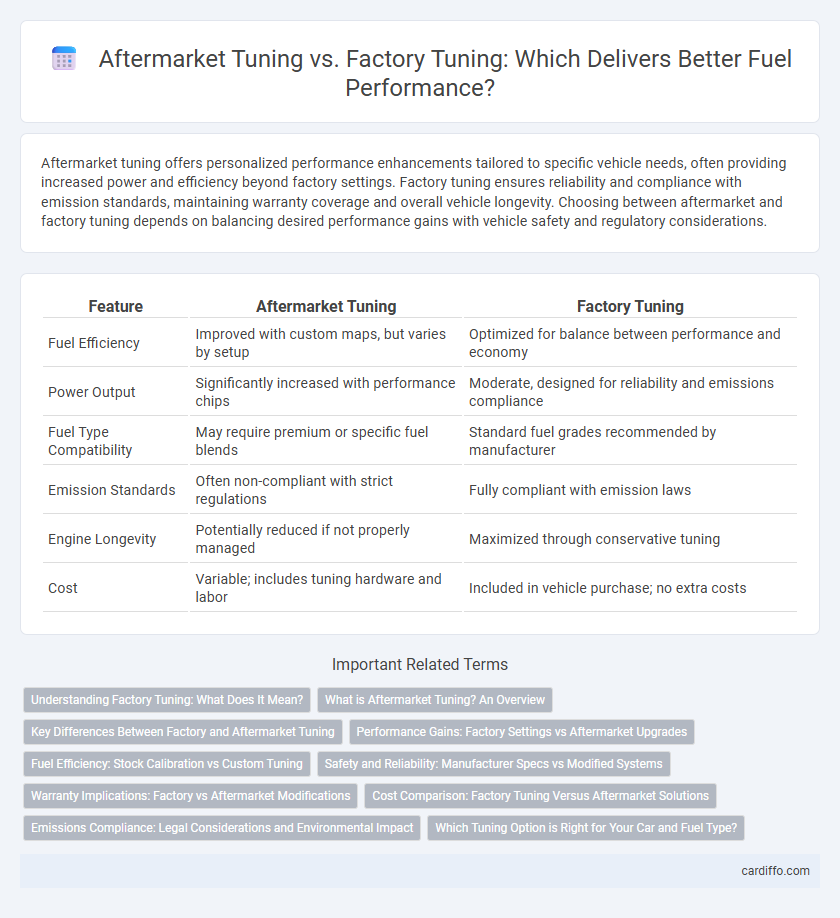Aftermarket tuning offers personalized performance enhancements tailored to specific vehicle needs, often providing increased power and efficiency beyond factory settings. Factory tuning ensures reliability and compliance with emission standards, maintaining warranty coverage and overall vehicle longevity. Choosing between aftermarket and factory tuning depends on balancing desired performance gains with vehicle safety and regulatory considerations.
Table of Comparison
| Feature | Aftermarket Tuning | Factory Tuning |
|---|---|---|
| Fuel Efficiency | Improved with custom maps, but varies by setup | Optimized for balance between performance and economy |
| Power Output | Significantly increased with performance chips | Moderate, designed for reliability and emissions compliance |
| Fuel Type Compatibility | May require premium or specific fuel blends | Standard fuel grades recommended by manufacturer |
| Emission Standards | Often non-compliant with strict regulations | Fully compliant with emission laws |
| Engine Longevity | Potentially reduced if not properly managed | Maximized through conservative tuning |
| Cost | Variable; includes tuning hardware and labor | Included in vehicle purchase; no extra costs |
Understanding Factory Tuning: What Does It Mean?
Factory tuning refers to the engine calibration settings established by the vehicle manufacturer to optimize performance, fuel efficiency, and emissions compliance under standardized conditions. These settings are the result of extensive testing and engineering, ensuring reliability and adherence to warranty standards. Understanding factory tuning helps in evaluating how aftermarket tuning modifies parameters like air-fuel ratio and ignition timing beyond these preset limits to potentially enhance power or fuel economy.
What is Aftermarket Tuning? An Overview
Aftermarket tuning involves modifying a vehicle's engine control unit (ECU) settings beyond the manufacturer's original parameters to enhance performance, fuel efficiency, or responsiveness. This process uses specialized software and hardware components to adjust fuel injection, ignition timing, and boost pressure, catering to specific user preferences or driving conditions. Unlike factory tuning, aftermarket tuning offers customizable options that can optimize engine output or adapt to aftermarket parts for improved overall performance.
Key Differences Between Factory and Aftermarket Tuning
Factory tuning is engineered by manufacturers to optimize fuel efficiency, emissions, and engine reliability adhering to strict regulatory standards. Aftermarket tuning customizes engine parameters to enhance performance, often increasing fuel consumption and emissions due to aggressive fuel maps and ignition timing. Key differences include software flexibility, warranty implications, and impact on engine longevity, with aftermarket tuning offering higher performance potential at the cost of manufacturer guarantees.
Performance Gains: Factory Settings vs Aftermarket Upgrades
Factory tuning optimizes fuel maps and ignition timing for reliability and emission standards, resulting in moderate performance gains optimized for daily driving conditions. Aftermarket tuning offers significant performance gains by recalibrating air-fuel ratios, increasing boost pressure, and adjusting ignition timing beyond factory limits, enhancing horsepower and torque. These upgrades often require higher-octane fuel and advanced engine management systems to maintain optimal fuel combustion and prevent engine knock.
Fuel Efficiency: Stock Calibration vs Custom Tuning
Factory tuning prioritizes balanced fuel efficiency and emissions compliance using stock calibration optimized for broad driving conditions. Aftermarket tuning customizes fuel maps to enhance engine performance and fuel economy, often achieving better mileage under specific driving styles. However, improper custom tuning can lead to increased fuel consumption and engine wear, making precision calibration essential for optimizing fuel efficiency.
Safety and Reliability: Manufacturer Specs vs Modified Systems
Factory tuning adheres to rigorous manufacturer specifications, ensuring optimal safety and reliability through controlled fuel delivery and engine management systems designed for extensive testing. Aftermarket tuning often modifies fuel maps and boost pressures beyond stock settings, which can increase performance but may compromise engine durability and increase risks of component failure. Maintaining a balance between enhanced power and preserving OEM reliability is crucial when altering fuel systems outside factory parameters.
Warranty Implications: Factory vs Aftermarket Modifications
Factory tuning preserves the vehicle's original warranty by adhering to manufacturer specifications and standards, ensuring coverage for mechanical and electronic components. Aftermarket tuning often voids the warranty because it involves unauthorized modifications that can affect engine performance, emissions, and vehicle safety systems. Manufacturers typically exclude damage or failures resulting from aftermarket parts or software upgrades, leaving owners responsible for repair costs.
Cost Comparison: Factory Tuning Versus Aftermarket Solutions
Factory tuning typically involves higher upfront costs due to the use of OEM parts and precise calibration by manufacturers, ensuring warranty compliance and reliability. Aftermarket tuning solutions offer a more budget-friendly alternative with a wider range of customizable options, though they may risk voiding vehicle warranties and require frequent adjustments. Comparing costs reveals that aftermarket tuning provides greater flexibility for fuel performance enhancements without the premium price of factory settings.
Emissions Compliance: Legal Considerations and Environmental Impact
Aftermarket tuning often alters engine parameters beyond factory specifications, which can lead to non-compliance with emissions regulations set by agencies such as the EPA and CARB, resulting in potential legal penalties and voided warranties. Factory tuning ensures emissions compliance by adhering to strict environmental standards and incorporating advanced emission control technologies like catalytic converters and EGR systems. Non-compliant aftermarket modifications can increase harmful pollutants like NOx and CO2, negatively impacting air quality and contributing to environmental degradation.
Which Tuning Option is Right for Your Car and Fuel Type?
Aftermarket tuning offers customizable fuel maps tailored to specific fuel types, improving performance and efficiency beyond factory settings designed for standard fuel quality. Factory tuning ensures reliability and compliance with emission standards, optimizing fuel injection and ignition timing for typical fuel grades. Choosing the right tuning depends on your car's make, fuel compatibility, and whether you prioritize peak performance or long-term engine stability.
Aftermarket Tuning vs Factory Tuning Infographic

 cardiffo.com
cardiffo.com